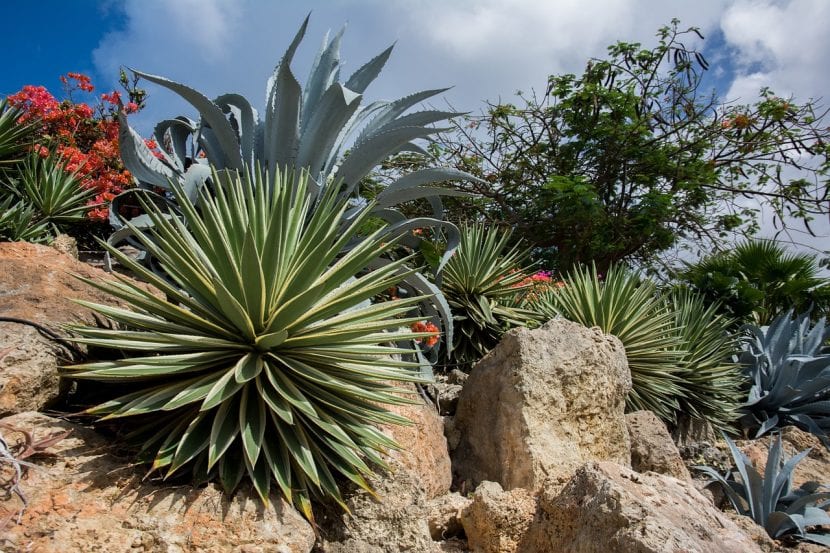
When we talk about succulents we refer to a series of plants that live in areas where rainfall does not usually fall too often. To survive, what they have done has been to transform little by little, over thousands and even millions of years, the leaves and / or stems in their own water stores. Thanks to these reservations they are able to grow in the desert.
But there is a lot of confusion about what are succulents, and even more the care they need. To try to solve them we are going to offer you an article that pretends to be the mega-guide of these magnificent plants from this blog, Jardinería On.
What are succulent plants?
If we start from the term, succulent, it comes from the Latin suculentus which means very juicy. This means that there is one or more parts of the plant (leaves, stems, trunk) which allows the storage of water in much larger quantities than in the rest of the plants.
They are distinguished into three types: cacti, succulents and plants with caudex or caudiciform plants.
Cactus
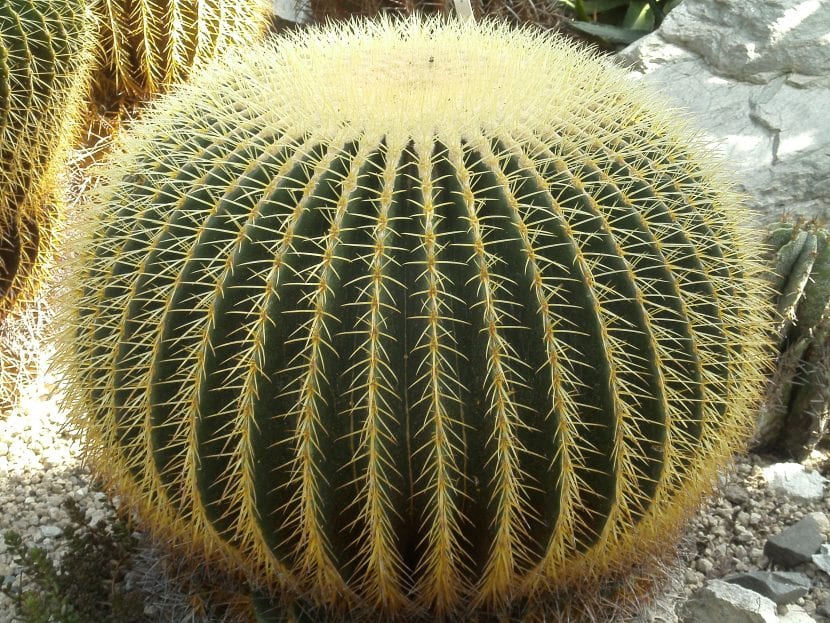
Echinocactus grusonii
Cacti are those plants that, in general, we could say that they are characterized by having thorns that cause a lot of damage to those who dare to touch them, or who carelessly rub against them. But, What if I told you that thorns are not the hallmark of this type of succulents?
You wouldn't believe me, would you? I understand it, but… being so I have to tell you something: there are species that do not have spines or that have them so short that they are barely visible. Examples there are several: Astrophytum asterias, Astrophytum cv Nudum, Echinopsis subdenudata, Trichocereus pachanoi, Myrtillocactus geometrizans, Lophophora williamsii and L. diffussa,...
Thorns are very useful to those plants that have them: They protect them a little from the sun, prevent animals from eating them and also help them to collect more water. What water? The dew one, of course. The droplets settle on all parts of the cactus, also on the thorns which, as they grow slightly upwards, the water slides towards the plant, where it can be absorbed through the pores that it has on its surface.
What do we have to look at when we want to know if a plant is a cactus or another succulent? In the areolas. From them, the thorns emerge -if they have them- and the flowers. They are on the ribs, which are structures that are specially designed to avoid excessive loss of water through evaporation.
Cacti take two types of shapes: columnar, being able to reach a height of up to ten meters, or globular, but it should be noted that some are epiphytes, such as Schlumbergera, and others that form clusters with many suckers, such as Mamillaria elongata for example.
They are originally from America, especially from the central part.
Succulents
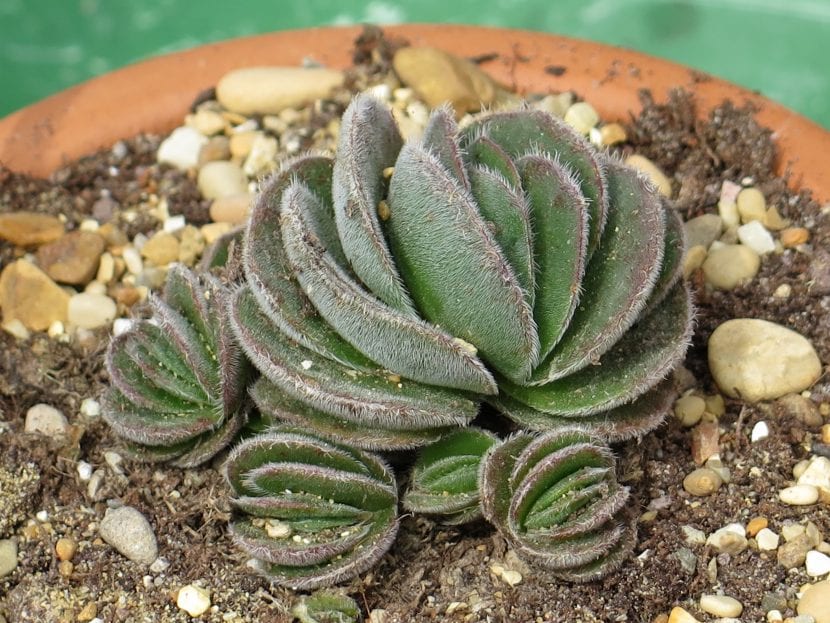
Crassula barbata
Succulents, succulents, or non-cacti plants are those that take on shapes and have colors that could easily be mistaken for small works made by an artist. Fortunately for us (perhaps not so much for our pockets) they are living beings that, as we will see later, are really easy to care for.
How are they different from cacti? Mainly, in two things: they have no areoles and the flowers sprout from a terminal stem, that is, as soon as the flowers wither, the stem will too. The leaves and / or stems are fleshy, and can be of various forms: elongated, more or less flattened, grow in the form of a rosette, thin, ... There are some that have something similar to thorns, such as euphorbia enopla, but these do not arise from the areolas, but from the stem itself.
Mostly, it involves compact plants, which does not exceed thirty or forty centimeters in height. However, there are some that have a bushy shape, with a height of up to two meters or more, as is the case of the Crassula ovata.
They are mainly native to Africa, although they can also be found in Europe.
Plants with caudex

Pachypodium lamerei var. ramosum
Finally, we have the plants with caudex or caudiciforms. They are some of the most curious plants, since apparently they are plants, let's say, normal, with common leaves and flowers, but the trunk ... the trunk does something that no tree can do: store water in large quantities.
Due to this adaptation mechanism, they can withstand long periods of drought reasonably well. In fact, if they have a problem, there are species that choose to sacrifice branches. Yes, yes: if they are in trouble, they stop feeding a branch and get rid of it. Then they seal the wound, and voila. In this way, they will not have to waste so much water.
We can find them in Africa, the best known being the Adenium obesum (Desert rose), fockea edulis y Cyphostemma juttae.
How are they cared for?
Now that we more or less have an idea of what each of the succulents are like, it is time to move on to the care they need. When we want to have a small collection, or if we want to have some potted plants we have to keep in mind that it will be very necessary provide them with a series of attentions so they can look and be healthy. Therefore, after many years cultivating them, I am going to recommend the following:
Put your succulents in a bright area
In order to grow and have an excellent development, this is perhaps one of the most important things to know. They do not grow well in shady placesNor in those where they do not receive direct sunlight for a minimum of five hours. Of course, if they have been bought in a nursery where they were protected from the star king, they should not be exposed to him abruptly since otherwise they would burn.
In order for them to get used to it little by little, for two weeks they will be placed in an area where the sun shines for an hour, two at the most. The third and fourth week, we will extend the exposure time by 1-2h. plus; and so on progressively until we can leave them all day. If we see that red or brown spots begin to appear, we will go more slowly. This must be done in spring, when the sun is not yet very strong.
There is an exception and they are haworthia. These succulents prefer to be in semi-shade, without direct light.
Use substrates that have very good drainage
The soil where they grow in their natural habitat is sandy, with an excellent sewer system. You cannot put a substrate that does not drain the water well because if you do, the roots will rot. That is why I personally I recommend simply using pumice, or if you can't get it, black peat mixed with perlite, arlite or river sand washed in equal parts.
Another option would be to buy a ready-made cactus substrate, but these sometimes do not have the drainage they claim to have. When in doubt, it is preferable to mix it with any of the materials mentioned above (clay, perlite, river sand).
Water when the substrate is dry
Watering is very important for all plants, also for succulents. During the summer they should be watered an average of twice a week, and during the rest of the year an average of one. But you have to know that the frequency will actually depend more on the climate we have and how long the substrate remains wet.
So, so that there are no problems, you should check the humidity by doing any of these things:
- Introduce a thin wooden stick: if it comes out practically clean when it is extracted, we will water as the substrate will be dry.
- Using a digital moisture meter: when introduced into the ground, it will instantly tell us if it is wet or not. I advise introducing it in other areas (closer to the plant, closer to the edge of the pot) to make it more reliable.
- Weigh the pot once watered and again after a few days: the humid substrate weighs more than the dry one. This difference in weight can serve as a guide.
When winter comes, watering should not be neglected. It's not good to let them wrinkle, because if they reach this point it will mean that they have been so thirsty that they have had to almost exhaust their water reserves. The frequency of watering should decrease, but never let the plants go to this extreme.
If you have a plate under them, We will remove the excess water after ten minutes having watered.
Fertilize them regularly
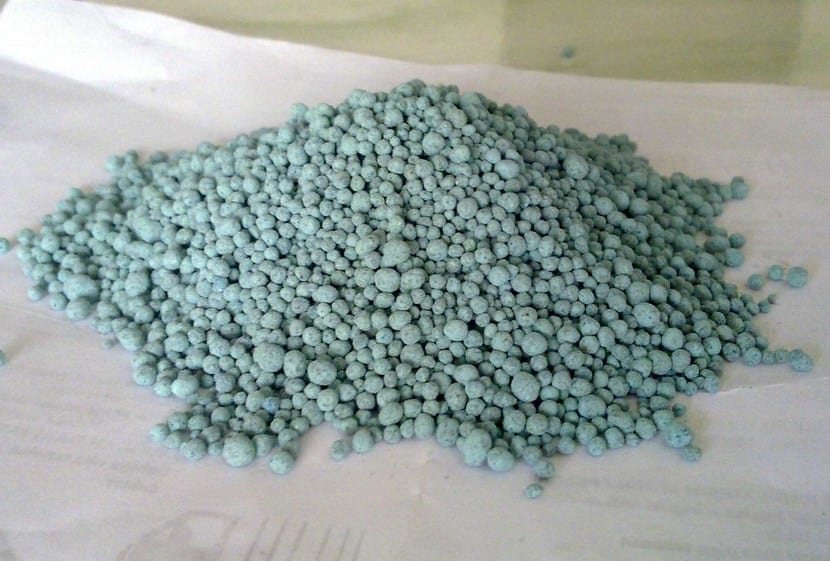
Throughout the growing season, that is, in spring and summer, They must be paid so that they can grow, develop, and when the time comes, flourish and bear fruit.. Only with water they cannot survive, but if they are given an inadequate compost they will not be able to do much either. Let me explain: where they come from, there is hardly any decomposing organic matter, so succulents have evolved to absorb the minerals found in the soil.
If we fertilize them with organic fertilizers, it will be as if we did nothing, because they do not know how to take advantage of it. Therefore, it is necessary to use mineral fertilizers, either liquid or in granules. In the nurseries we find fertilizers for cacti and all kinds of succulents, but we can also use Blue nitrophoska or Osmocote. In any case, we have to follow the instructions specified on the packaging and not overdo the dose.
Change them pot whenever they need it
One of the problems that succulents have is that they are not usually changed pot. It is easy to think that they are small and that they will not grow any more, but the truth is that if they spend a lot of time in the same container they end up weakening in the end, developing badly and / or dying for lack of space and minerals.
Therefore, We must change the pot as soon as we buy them -as long as it is spring or summer, and they are not in flower- and again after two or three years. This container can be made of plastic or clay, the latter being especially advisable as it allows the roots to be better grasped; In addition, it is more durable.
Now, if you plan to have a collection, the plastic ones end up being more profitable, especially if you buy those designed to be outdoors. They have a somewhat higher price, but the material is more resistant to environmental conditions.
Multiply them in spring or summer
If you want to have new specimens we can do the following: sow their seeds or make cuttings. How to proceed in each case ?:
Seeds
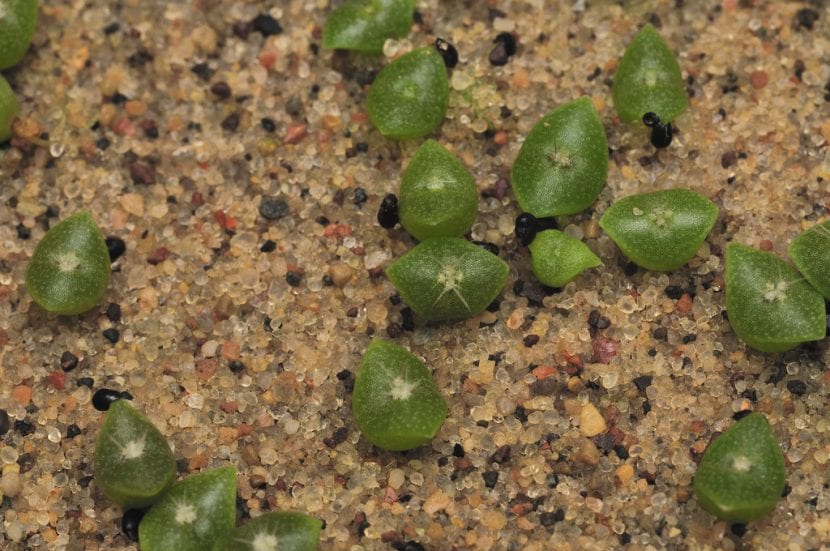
Saguaro seeds germinating.
To sow the seeds do the following:
- The first thing to do is fill a pot with well-draining substrate, like the ones we mentioned before.
- Afterwards, it is watered conscientiously, moistening it well.
- Then, the seeds are spread on the surface, trying to be a little separated.
- They are then covered with a very thin layer of substrate.
- Finally, the seedbed is placed inside a semi-shaded plate or tray, and water is poured into the tray.
Germination time varies from one species to another. Some take three days and there are others that can take two months.
Cuttings
Whether they are stem or leaf cuttings, it is advisable to follow these steps:
- First, those cuttings (leaves or stems) that look healthy and strong must be chosen.
- Then a pot is filled with suitable substrate.
- They are then placed lying down in the pot, with the end that held them together with the mother plant a little buried. In the case of Aeonium cuttings, they can be planted straight without problem.
- Afterwards, it is watered consciously.
- Finally, the pot is placed in a place where it is in direct sunlight.
In a matter of a few days (a week or two at the most) they will take root.
Protect them against pests and diseases
Although they are quite resistant plants to pests and diseases, you have to watch the mollusks (snails y slugs) and the aphids. The former are capable of eating them in a matter of a few days, and the latter are insects that feed on the flower buds and the still unopened flowers. To treat them you have to use specific insecticides, or natural ones such as neem oil.
You also have to be alert not to water excessively, because doing so the roots would suffocate and the plants would rot quickly. If we see that they begin to get very soft, we will cut to the health, we will remove them from the pots and we will let the substrate dry completely before planting them again.
Beware of cold and frost
The majority it does not resist cold or temperatures below -2ºC. Hail can cause a lot of damage to the leaves of succulents and caudiciforms, and also to cacti. When in doubt, it is always better to prevent them by keeping them indoors, in a very bright room protected from drafts.
Curiosities of succulents
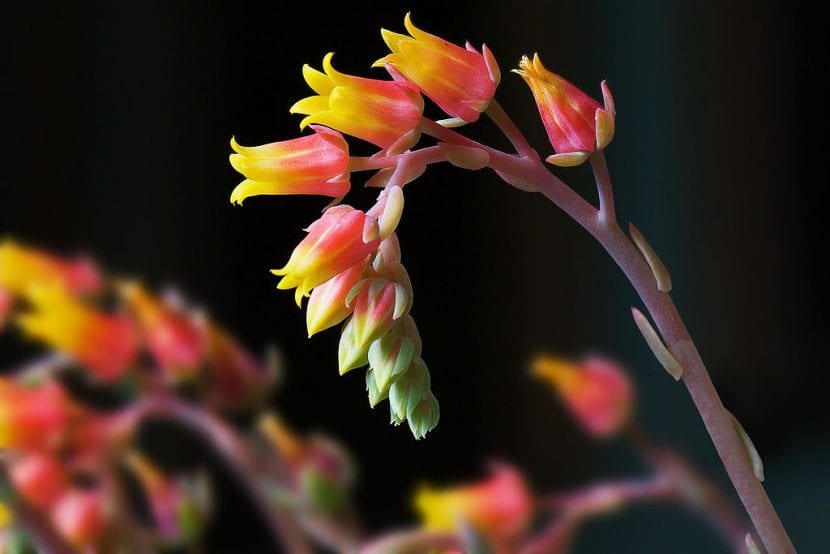
Flowers of echeveria glauca.
To finish, let's see what are the curiosities of these magnificent plants:
Cactus curiosities
- The Cactaceae family is composed of a total of 170 genres, which have about 2000 species.
- The gender pereskia it is considered the most primitive of all. It has leaves, areoles, and thorns, and it appeared 40 million years ago.
- If root system is superficial, but it can be quite long. Columnar, like the The giant carnage (saguaros) they can have roots up to 2 meters in length.
- All cacti produce flowers, but in nurseries and garden stores many times they are beaten to sell more.
- El cactus computer (Cereus peruvianus) does not protect against radiation. For it to be really useful we would have to put specimens of this species covering the entire monitor, something that obviously is not done.
- There are hallucinogenic cactusand peyote (Lophophora williamsii) or the San Pedro (Trichocereus pachanoi). Both have been used in shamanic rituals for being powerful hallucinogens.
- La prickly pear (Opuntia ficus-indica) has medicinal properties: its fruits are astringent. Although he is not the only one: the Corryocactus brevistylus it is used as a laxative.
- The saguaro (The giant carnage) may have up to 8000 liters of water inside.
Curiosities of the succulents and caudiciforms
- The photosynthesis carried out by the Crassulaceae consists of two phases: a light that is produced during the day releasing carbon dioxide (CO2) and producing food, and a synthetic one (at night) that is when they absorb CO2. It is known as CAM photosynthesis, or crassulaceae acid metabolism.
- The Sempervivum are one of the few that can withstand frosts down to -4ºC, although yes, the hail can hurt them unless they are a little sheltered.
- All the caudiciform they are plants of very slow growth. Many do not exceed 5cm / year. This is because they have evolved adapting to an environment where conditions are not the most appropriate for rapid development. Still, their life expectancy is usually long: more than 300 years.
And with this we are done. What did you think of the succulents?
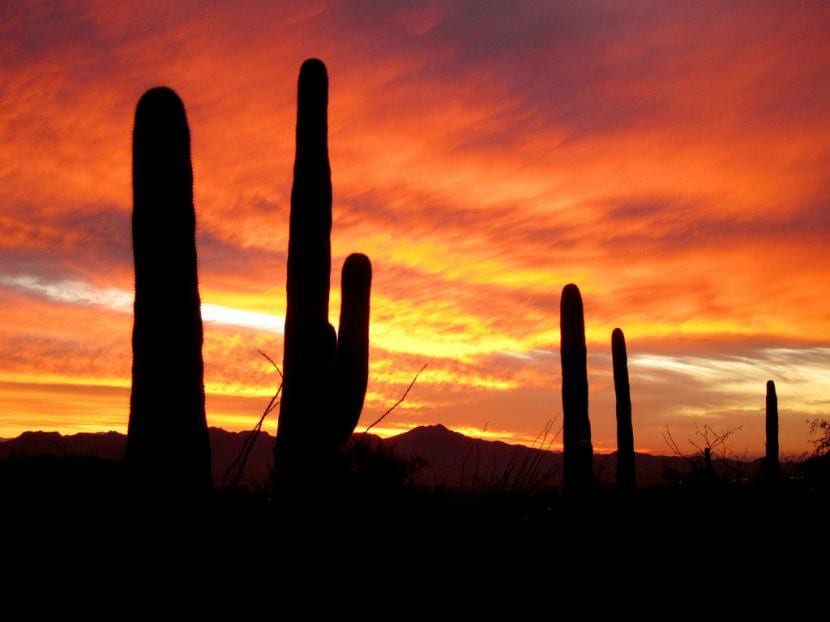
IT IS INTERESTING WHAT YOU WRITE ABOUT JARDINERIAON
We're glad it's of interest to you, Deisy. 🙂
very good information friends !! regards
We are glad that you have been interested, Jesus 🙂
Hello, as I understood then the cacti are succulents? I have an arrangement business with these plants and I bought books whose titles are: Cacti and Succulents and they handle them as two different groups.
Hi Alejandra.
If that is. There is still a lot of confusion, but yes, cacti are succulents since they store a large amount of water in their bodies, in the same way that an Echeveria for example does in its leaves.
But precisely because there are still many people with doubts, they keep saying cactus y succulents, which is a mistake.
A greeting.
Hello, HELP, I have a succulent (a small aloe, I don't know what kind exactly, but I don't think it's "aloe vera"), the fact is that its leaves are very thin, they used to have "carnita", although they can't be seen brown, if anything only the tips look a little burned, and the whole blade curls in like a wad, but not as much. I'm worried, I don't know if it lacks or has excess water, if I gave it too much sun, if it lacks nutrients, what should I do?
Hi Eily.
There are some plants similar to Aloe vera which, like him, grow best in semi-shade. If the sun hits them, their leaves burn and the plant can spoil. For example, haworthia or gastronomy.
Regarding irrigation, you have to water little: about 2 times a week in summer and less in winter. In the links you have more information.
If you have doubts, contact us again.
Greetings.
VERY GOOD DESCRIPTIONS, THANK YOU VERY MUCH !!
Thank you very much, Paola, for stopping by 🙂
Thanks for the content 🙂
Thanks to you for commenting 🙂